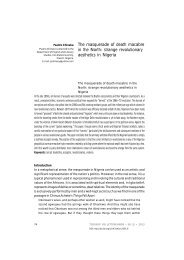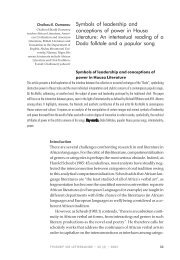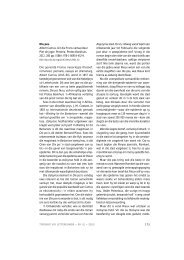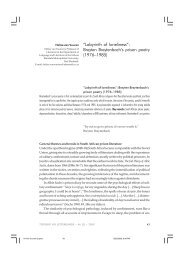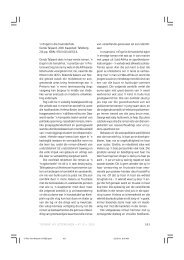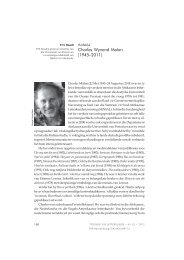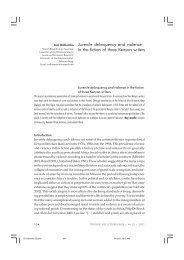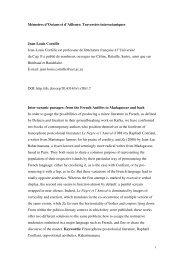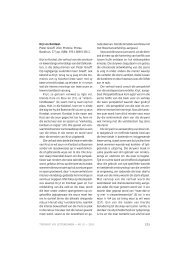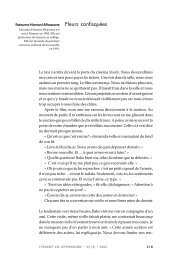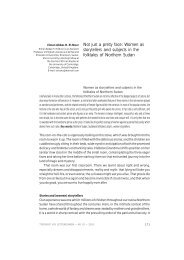Create successful ePaper yourself
Turn your PDF publications into a flip-book with our unique Google optimized e-Paper software.
that of a set of modern Johannesburgers,Walter and Albertina Sisulu, Phillip Tobias,Bram Fischer, Peter Magubane, Geoff Lockwood,Lionel Abrahams and SibongileKhumalo and her father Khabi Mngoma.The story of the Sisulus is told tenderly,befitting the gentle yet tough couple whocame to make Johannesburg their homeand the home also of the national struggleagainst apartheid. This is echoed in the portraitsof Bram Fischer, one of the most significantSouth Africans of his generation,and Peter Magubane, amongst the country’sforemost photographers. The tormentsuffered by Bram Fischer is felt on the tip ofAlfred’s pen, as is the frustration experiencedby Ngubane through one period ofincarceration followed by another duringthe height of apartheid. The challenges ofthe modern apartheid city are vividly alsopainted in the lives of Phillip Tobias, livingout his humanity through his incrediblecontributions to modern science, and surelyone on whom should have been bestowedthe Nobel prize for his palaeo-anthropologicalwork, Geoff Lockwood and his life’swork on the beautiful birds of South Africa,the amazingly generous Johannesburgmuse, Lionel Abrahams (who sadly died asthis review was being written), and the incomparablemusical talents of Khabi Mngomaand his daughter.The writing in this book is punchy andsharp. Alfred’s approach to his task is directand unafraid. The technique often rests onthe use of the short sentence accompaniedby longer, sometimes more discursivelyconstructed phrases and clauses. He is notafraid to use a well-worn phrase if it suitshis purpose. In using it, it emerges freshand apposite. The writing is, as a result, attractiveand direct. It reads fluidly and convincingly.Not unexpectedly, comment on the collectionof characters in Alfred’s cast is unavoidable.In the midst of the great numberof people who make up the gallery of Johannesburg’sheroes, never-mind its roguesand just plain ordinary types, it is a matterof interest that this particular group of peopleis assembled. It could be said that thebook leans too heavily in the direction ofJohannesburg’s white history, or, moregenerously, its liberal history. Even if oneaccepts that this cast features large in keymoments in the city’s life, a question couldbe asked about the omission of characterssuch as Moses Kotane, Clements Kadalie,Solly Sachs, or modern figures such as IsmailMohamed, W. Kambule, and Zeph Mothapeng.One could point to many more in theblack community. Alfred explains that thepeople represent his personal fascinations.This as an explanation is fine up to a pointbut a little more historiographic justificationis called for here. It would be useful tohear what meta-story animates this fascination,if only to be able to have a fair squaring-offwith Alfred about how one narratesa municipal history. And that in itself, evenin a relatively modest book such as this,would be a really valuable provocation.Having made these last remarks, thebook is a thoroughly enjoyable read. Evenfor those who would have grown up in Johannesburgthere is much to learn.Crain SoudienUniversity of Cape TownDie stilte na die boek: Kitsessays.Etienne van Heerden. Kaapstad: Tafelberg.2004. 207pp. ISBN 0-624-04215-4.Die 66 tekste in hierdie versameling, verteldie skrywer in ‘n Nawoord, is ‘n keur uitrubrieke onder die oorkoepelende titelKommapunt, wat in Die Burger verskyn heten ook oorgeneem is deur Beeld en Volks-TYDSKRIF VIR LETTERKUNDE • 41 (2) • 2004 218




